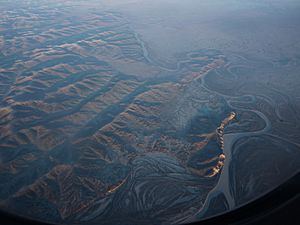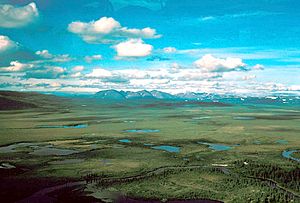Koyukuk River facts for kids
Quick facts for kids Koyukuk River |
|
|---|---|

Flowing through the Kanuti National Wildlife Refuge
|
|
|
Location of the mouth of the Koyukuk River in Alaska
|
|
| Native name | Ooghekuhno' / Kuuyukaq |
| Country | United States |
| State | Alaska |
| Census Area | Yukon-Koyukuk |
| Cities | Evansville, Bettles, Allakaket, Hughes, Huslia |
| Physical characteristics | |
| Main source | confluence of North and Middle forks Brooks Range 715 ft (218 m) 67°02′49″N 151°04′26″W / 67.04694°N 151.07389°W |
| River mouth | Yukon River Koyukuk 115 ft (35 m) 64°55′24″N 157°33′14″W / 64.92333°N 157.55389°W |
| Length | 425 mi (684 km) |
| Basin features | |
| Basin size | 32,000 sq mi (83,000 km2) |
The Koyukuk River is a long river in Alaska, a state in the United States. It flows for about 425 miles (684 km) and is a major branch, or tributary, of the mighty Yukon River. The Koyukuk is the last big river that joins the Yukon before the Yukon River flows into the Bering Sea.
The river starts where its North and Middle branches meet. This happens in the Brooks Range, a mountain chain in northern Alaska. From there, the Koyukuk River flows generally southwest. It eventually meets the larger Yukon River near the town of Koyukuk.
The Koyukuk River's source is above the Arctic Circle in the Endicott Mountains. The river's watershed, which is the land area that drains into it, is north of the Yukon River. This area includes parts of the Gates of the Arctic National Park and Preserve, the Kanuti National Wildlife Refuge, and the Koyukuk National Wildlife Refuge.
Several communities are located along the main part of the river. These include Evansville, Bettles, Alatna, Allakaket, Hughes, and Huslia. Many smaller rivers and streams flow into the Koyukuk. Some of its important branches are the Alatna River and the John River. Other major tributaries further downstream include the Kanuti, Hogatza, and Huslia rivers.
Contents
Wild and Scenic Rivers
Some parts of the Koyukuk River system are protected as "National Wild and Scenic Rivers." This means they are kept in their natural state. The Alatna, John, and North Fork of the Koyukuk are all part of this special system. The Tinayguk River, which flows into the North Fork, is also protected.
What's in a Name?
The name Koyukuk comes from the Yup'ik language. The word kuik-yuk means "a river." A Russian explorer named Petr Vasilii Malakhov gave the river this name in 1838. He didn't know the local Koyukon name for it, which is Ooghekuhno'.
Later, during the Western Union Telegraph Expedition, the river was spelled Coyukuk. But the United States Board on Geographic Names later decided on the spelling Koyukuk, which is what we use today.
River History
In 1838, the Russian explorer Petr Vasilii Malakhov was the first European to reach the Koyukuk River where it meets the Yukon. After the American Civil War, the United States bought Alaska. In 1885, two U.S. Army members, Lieutenant Henry Allen and Private Fred Fickett, explored the river.
The Gold Rush Era
In 1893, gold was discovered on the Middle Fork of the Koyukuk River. This discovery led to a gold rush in 1898. Many people came to the area hoping to find gold. Trading posts and mining camps, like Bettles, quickly grew up along the upper parts of the river.
Protecting the River
In 1929, an explorer and wilderness activist named Robert "Bob" Marshall explored the North Fork. He named a special area the Gates of the Arctic.
In 1980, the United States Congress decided to protect 100 miles (164 km) of the North Fork of the Koyukuk River. They called it the Koyukuk Wild and Scenic River. This helps keep the river's natural environment safe.
Recent Events
In 1994, the Koyukuk River experienced a big flood. This flood caused damage to three villages along the river. The people living there had to move to new locations for safety.
Plants and Animals
The plants along the Koyukuk River change as you go downstream. In the upper parts, the vegetation is sparse. You'll find tundra plants like small dwarf willows, other shrubs, sedges, and lichens.
Further down the river, at lower elevations, you'll see plants typical of taiga and boreal forests. These include trees like mountain alder, trembling aspen, white spruce, and black spruce. However, in the Koyukuk Flats near the river's mouth, the ground is often wet and swampy. Here, sedges and other herbaceous plants are common.
Fish Life
Many types of fish live in the Koyukuk River. In the lower parts, you might find Arctic lamprey and sockeye salmon. Different kinds of salmon, including sockeye, Chinook, and chum, also live in the upper parts of the river and its smaller branches.
Mammals and Birds
Caribou herds travel across the upper areas of the Koyukuk watershed. Other large animals in the region include bald eagles, brown bears, black bears, mink, beaver, marten, and river otter. Sometimes, Beluga whales even swim up the lower Koyukuk River!
Moose are also common in some parts of the river's watershed, especially near the riverbanks downstream from Hughes. These moose attract local hunters, as well as bears and wolves. Hunters and wildlife officials work together to make sure the moose population stays healthy.
Insects and Other Small Creatures
Scientists haven't studied the small creatures, called invertebrates, of the Koyukuk River as much. But general information suggests there are many types of insects. These include various kinds of flies, midges, black flies, mayflies, stoneflies, and caddisflies.
See also
 In Spanish: Río Koyukuk para niños
In Spanish: Río Koyukuk para niños




